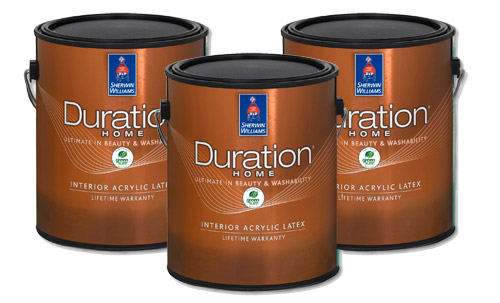If you’ve researched paints either online or at a paint store you’ve no doubt come across paints that say they are a paint and primer in one, so-called “self-priming paints.” Simply apply one coat of these paints, they claim, and you’ve painted and primed.
While many do-it-yourselfer painters may take that claim and run with it, professionals are more cautious, mainly because primer and paint serve different purposes. Paint with warranties, A primer is used for:
- Sealing in tannins, grease, smoke stains, etc. to ensure they don’t bleed through the fresh coat of paint.
- Improving the surface for paint to adhere to, making it last longer.
- Creating a uniform surface to which makes the paint coat more attractive.
 Paints are meant to provide a finished look in both color and texture, including a uniform and lasting appearance. While professionals such as Eric Morud of Edina-based TruNorth Painting note that combination paint and primers, such as Sherwin Williams Duration, make an excellent primer or paint on its own, he wouldn’t take the shortcut some other painters do and use one coat for both.
Paints are meant to provide a finished look in both color and texture, including a uniform and lasting appearance. While professionals such as Eric Morud of Edina-based TruNorth Painting note that combination paint and primers, such as Sherwin Williams Duration, make an excellent primer or paint on its own, he wouldn’t take the shortcut some other painters do and use one coat for both.
“The primer-paint combinations do have a thicker composition,” Morud said. “But we also know that each primer has its own special properties for particular surfaces such as wood, metal, concrete and interior walls.
“Primers both seal the surface and help paint bond to it. Some primers do both, but they tend to do one better than the other,” said Morud. That means that the primer in a self-priming paint may seal when it makes more sense for a primer to create surface for paint to bond to, or vice-versa.
That’s why Morud’s advice is simple: Limit your risk by using a primer as a primer and a paint as a paint and use the right primer for the job. Because all self-priming paint is latex they don’t seal the surface, allowing for tannins, oils, stains, etc. to bleed through the surface paint.
Morud suggests understanding the needs of the paint job. First, make sure the surface is dry — less than 15% moisture content using a moisture meter — and use an oil-based primer if you are painting wood or metal. Oil-based primer will seal oils and tannins in wood and rust in metal.
A latex primer can be used on exteriors less than 30 years old or on non-wood such as stucco, fiber cement, LP SmartSiding, and Masonite. He also recommends that if you are uncertain and are seeking advice to have a professional examine the work site and offer recommendations. More info about Professional interior painting.
TruNorth is happy to offer that service. Simply call 952-831-1433 for an appointment.
